title
Points of View
artist
Jeffrey Shaw
intro
Points of View was Jeffrey Shaw’s first interactive work and utilised the participational concept of art that he had been developing since the 1960s. Three versions of Points of View were made: Points of View I (1983), Points of View II - Babel (1983), and Points of View III - A Three Dimensional Story (1984).
Shaw called the work a ‘theatre of signs’, with the stage and the protagonists provided by a three-dimensional computer graphics simulation that was video projected onto a screen in front of an audience. Any member of the audience could control the action of the work using two specially made joysticks which moved the virtual point of view. Sixteen soundtracks, of mostly spoken texts, were interactively linked to the image via the same joystick that controlled the visual movements.
The actors were represented on stage by hieroglyphic characters derived from the ancient Egyptian alphabet. This constellation of signs was used to articulate a world model with an underlying set of physical and conceptual relationships.
biography artist
Jeffrey Shaw (Melbourne, 1944) is regarded as one of the leading exponents of computer art and was one of the first artists to engage with participatory, interactive, and computer-controlled forms of media art. He has pioneered and set benchmarks for the creative use of digital media technologies in the fields of virtual and augmented reality, immersive visualization environments, navigable cinematic systems, and interactive narrative.
In 1967, together with Theo Botschuijver and Sean Wellesley-Miller, he established the Event Structure Research Group (ERG) and he was the founding director of the ZKM Institute for Visual Media Karlsruhe. He has held teaching positions at the Academie van Beeldende Kunsten, Rotterdam and at the Gerrit Rietveld Academie, Amsterdam; and in 1991 he became Director of the Institute for Visual Media at ZKM. Shaw has received numerous awards for his work, including the prize awarded at the Ferrara festival L'Immagine Elettronica (1990), and the 'Prix Ars Electronica' (1990).
keywords
video, installation, interactive, theater, flight simulation, software
images
[caption id="attachment_390" align="alignnone" width="640"]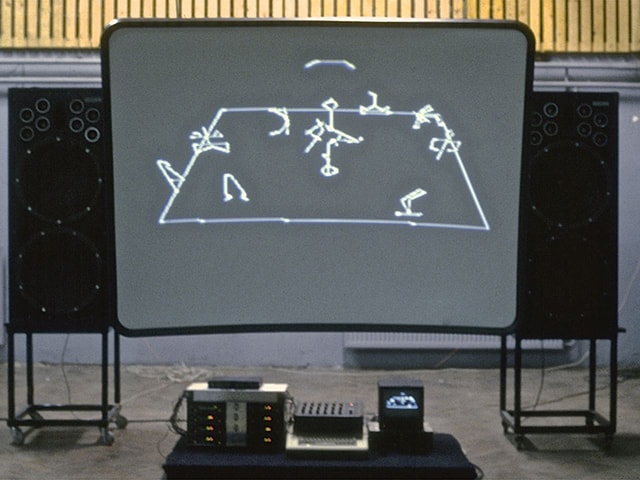 Jeffrey Shaw, Points of View, Mickery Theatre, Amsterdam, Netherlands, 1983.[/caption]
[caption id="attachment_389" align="alignnone" width="640"]
Jeffrey Shaw, Points of View, Mickery Theatre, Amsterdam, Netherlands, 1983.[/caption]
[caption id="attachment_389" align="alignnone" width="640"]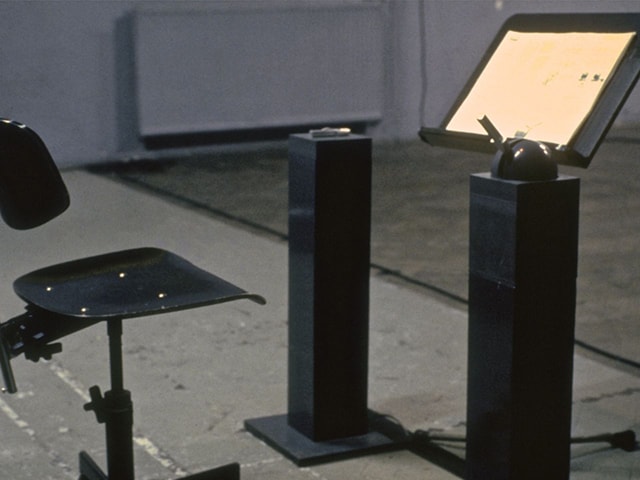 Jeffrey Shaw, Points of View, Mickery Theatre, Amsterdam, Netherlands, 1983.[/caption]
[caption id="attachment_391" align="alignnone" width="640"]
Jeffrey Shaw, Points of View, Mickery Theatre, Amsterdam, Netherlands, 1983.[/caption]
[caption id="attachment_391" align="alignnone" width="640"]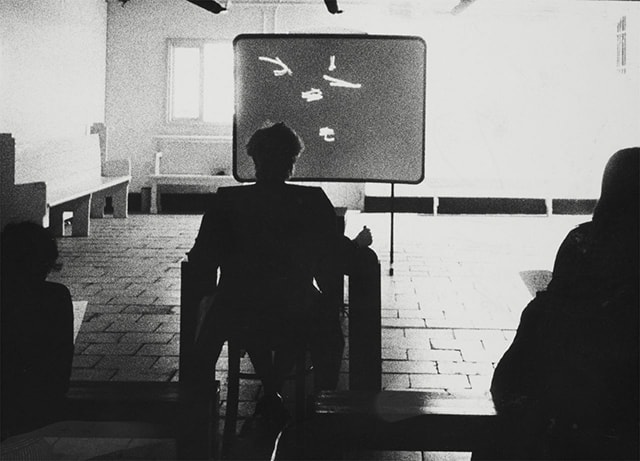 Jeffrey Shaw, Points of View, Apollohuis Gallery, Eindhoven, Netherlands, 1983.[/caption]
[caption id="attachment_392" align="alignnone" width="640"]
Jeffrey Shaw, Points of View, Apollohuis Gallery, Eindhoven, Netherlands, 1983.[/caption]
[caption id="attachment_392" align="alignnone" width="640"]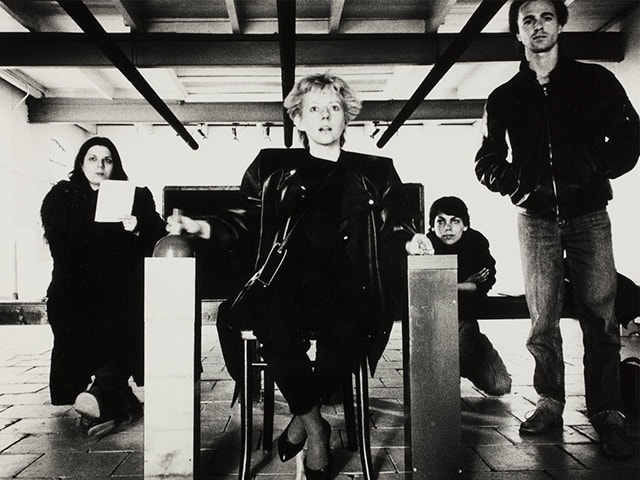 Jeffrey Shaw, Points of View, Apollohuis Gallery, Eindhoven, Netherlands, 1983.[/caption]
[caption id="attachment_393" align="alignnone" width="640"]
Jeffrey Shaw, Points of View, Apollohuis Gallery, Eindhoven, Netherlands, 1983.[/caption]
[caption id="attachment_393" align="alignnone" width="640"]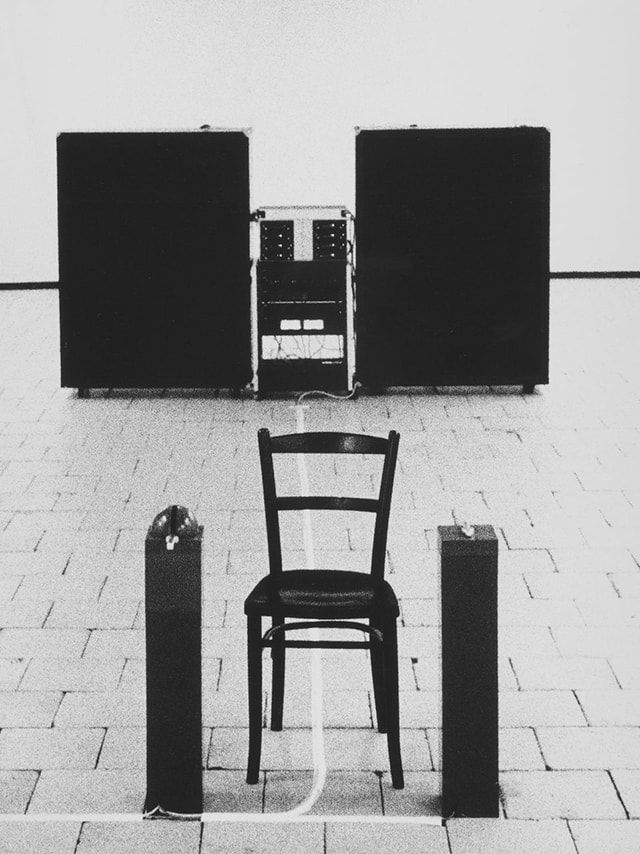 Jeffrey Shaw, Points of View, Apollohuis Gallery, Eindhoven, Netherlands, 1983.[/caption]
Jeffrey Shaw, Points of View, Apollohuis Gallery, Eindhoven, Netherlands, 1983.[/caption]
 Jeffrey Shaw, Points of View, Mickery Theatre, Amsterdam, Netherlands, 1983.[/caption]
[caption id="attachment_389" align="alignnone" width="640"]
Jeffrey Shaw, Points of View, Mickery Theatre, Amsterdam, Netherlands, 1983.[/caption]
[caption id="attachment_389" align="alignnone" width="640"] Jeffrey Shaw, Points of View, Mickery Theatre, Amsterdam, Netherlands, 1983.[/caption]
[caption id="attachment_391" align="alignnone" width="640"]
Jeffrey Shaw, Points of View, Mickery Theatre, Amsterdam, Netherlands, 1983.[/caption]
[caption id="attachment_391" align="alignnone" width="640"] Jeffrey Shaw, Points of View, Apollohuis Gallery, Eindhoven, Netherlands, 1983.[/caption]
[caption id="attachment_392" align="alignnone" width="640"]
Jeffrey Shaw, Points of View, Apollohuis Gallery, Eindhoven, Netherlands, 1983.[/caption]
[caption id="attachment_392" align="alignnone" width="640"] Jeffrey Shaw, Points of View, Apollohuis Gallery, Eindhoven, Netherlands, 1983.[/caption]
[caption id="attachment_393" align="alignnone" width="640"]
Jeffrey Shaw, Points of View, Apollohuis Gallery, Eindhoven, Netherlands, 1983.[/caption]
[caption id="attachment_393" align="alignnone" width="640"] Jeffrey Shaw, Points of View, Apollohuis Gallery, Eindhoven, Netherlands, 1983.[/caption]
Jeffrey Shaw, Points of View, Apollohuis Gallery, Eindhoven, Netherlands, 1983.[/caption]
year
1983
premiere
Points of View premiered at the Mickery Theatre in Amsterdam in 1983. In the same year it was also shown in the Netherlands at the Apollohuis Gallery in Eindhoven, Centrum ’t Hoogt in Utrecht, Kijkhuis in The Hague, and Lantaren Theatre in Rotterdam.
software
Custom developed software which used the subLOGIC ’flight simulator’ tool set
functionality
Shaw transferred the participational concept of art, which he developed during the 60s, to computer installations. As an interactive installation, Points of View includes a stage and actors, both of which are represented by a 3D computer graphics simulation that is video projected onto a large screen in front of a seated audience. The actors are represented on the stage by Egyptian hieroglyphic characters, and visitors are given a leaflet which explains the meaning of each character. Any member of the audience can interact with the work by using two custom designed joysticks to control the theatrical installation. The first joystick controls movements of the image of the stage and the second allows for steering around sound traces. With its use of techniques that were originally developed for flight simulation, this work allows the user to move their virtual point of view 360 degrees around the stage, 90 degrees up and down, and forwards and backwards. The audio, with up to sixteen channels of sound, is interactively linked to the joystick that controls the visual movements—modulating the volume of the various voices in relation to the virtual spatial position of the viewer.
Shaw has stated that “it is the particular audio visual journey made by a spectator who operates the joystick which constitutes a 'performance' of this work. For the other spectators that performance becomes ‘theater’.”4
‘Points of View II - Babel' (1983) and ‘Points of View III - A Three Dimensional Story’ (1984), use the same technical and functional structure as the first version, but have different content.
part of collection
production
Points of View was originally developed with the following people and organisations:
Software: Larry Abel
Hardware: Charly Jungbauer and Tat van Vark
Production: Mickery Theater, Amsterdam
Subsequent development of Points of View in 1999 was achieved with the assistance of Torsten Ziegler (software) and Armin Steinke (hardware).
The first two versions of Points of View were produced by the Mickery Theater. The third version, Points of View—A Three-Dimensional Story was supported by de Appel within the framework of Theater maken aan Televisie voorbij (Making theatre on television is over).1
In 1997, Shaw did a reconstruction of Points of View, which gave valuable insight into the procedure of platform migration. All of the components of the interactive artwork had become obsolete by 1997, so Shaw reconstructed the whole artwork in a more current technological environment, while respecting the exact look and feel of the original.2
hardware
Apple II computer
2x accelerator board
Monochrome video projector
Curved silver screen
Custom joysticks, connected to the Apple II paddle ports
Eight auto-reverse stereo cassette decks (sixteen separate mono channels)
Voltage controlled amplifiers
technical specs
“Points of View was realised using a standard Apple II computer with a 2x accelerator board. The application software was developed using the subLOGIC ’flight simulator’ tool set (a very early example of the crossover from military simulation, to gaming and art applications). The composite video out from the Apple II was sent to a first generation monochrome video projector, projecting onto a curved silver screen. Custom joysticks were developed (connected to the Apple II paddle ports). The sound was generated by eight auto-reverse stereo cassette decks (sixteen separate mono channels) and interactively modulated (by the user) using voltage controlled amplifiers. Live radio was a seventeenth available channel.
The accelerated Apple II was capable of drawing about 100 monochrome straight lines in a 3D space at a rate of about 8 frames per second! Screen resolution was about 380 x 280 pixels. Needless to say these parameters were a severe constraint on any visualisation ambitions, but specific choices were made that allowed the integrity of the art work to succeed and even capitalise on these limitations.”3
intention artistquote by artist
quote
“I have explored, and sometimes invented, many modalities of interactivity in my art practice. Certain denominators appear in many different guises in these works. It is pertinent that two of my earliest installations were titled Viewpoint (Paris, 1986), and Points of View (Amsterdam, 1989), because what I was researching were optical systems that gave the viewer personal methods, and personal control, of seeing and exploring the artworks’ spaces of representation.”5
“Points of View created an interactive navigable three-dimensional virtual world that was a new paradigm for the aesthetic and conceptual identity of an artwork. Part performance, part video game and part animated Constructivist sculpture, Points of View’s expression had to come to terms with the severe constraints of real time computer graphics systems in 1983 - Apple II’s low-resolution low frame rate monochrome display that only permitted the construction of a 3-D model constituted by a maximum of about 100 straight lines. This was the perceptual space of first generation video games, especially subLOGIC’s Flight Simulator (1983).”6
influence
Points of View created an interactive and navigable three-dimensional virtual world, which was a new paradigm for the aesthetic and conceptual identity of an artwork. It also established, for the first time, one of the basic ‘theatrical’ modalities of an interactive art installation. Presented in an actual theatre and showing a virtual theatre space, the work created new intersections between theatrical traditions and the virtual space. The work was also one of the first to use the expanded space of real-time flight simulations as an environment and tool for artistic projects.
Points of View exists on the threshold between earlier participative forms of art and an evolving paradigm of interaction with computers in an artistic context. Due to this position, and the pioneering quality of the work, it has influenced many artists working at the intersections of gaming, theatre, virtual reality, augmented reality, Expanded Cinema, interactivity, and participatory art practices.
context
LITERATURE
“Interview with Jeffrey Shaw on New Media Art.” Theory, Culture & Society, theoryculturesociety.org.
“Jeffery Shaw.” Vimeo, 19 Apr. 2018, vimeo.com.
Catala, Laurent. “[Portrait] Jeffrey Shaw, the Art of Interactive Cinema.” digitalarti.com, 24 June 2013, media.digitalarti.com.
Dinkla, Söke. “The History of the Interface in Interactive Art.” Ken Feingold, kenfeingold.com.
Hansen, Mark B.N. “Framing the Digital Image: Jeffrey Shaw and the Embodied Aesthetics of New Media.” New Philosophy for New Media. The MIT Press, 2004.
Ribeiro, Clarissa. “Entangled, Hybridized, Multiple.” V!RUS, Translated by Natalia Cortez Thomsem, no. 6, 2011, 143.107.236.240/virus.
Rokeby, David. “Transforming Mirrors: Subjectivity and Control in Interactive Media.” Critical Issues in Interactive Media.” edited by Penny Simon, SUNY press. pp. 113-158.
Stockburger, Axel. “The Rendered Arena: Modalities of Space in Video and Computer Games.” Axel Stockburger, University of the Arts, London , 2006, stockburger.at (pdf).
Shaw, Jeffrey. Jeffrey Shaw: A User's Manual / Eine Gebrauchsanweisung Von Expanded Cinema zur Virtuellen Realität / From Expanded Cinema to Virtual Reality. edited by Heinrich Klotz, Hatje Cantz, 1997.
Shaw, Jeffrey. “New Media Art Practices and Conservation.” AICCM, aiccm.org.au (pdf).
Shaw, Jeffrey. “The Legible City.” Presence and Representation in Multimedia Art and Electronic Landscapes, edited by Monika Buscher et al., Computing Department, University of Lancaster, 1998, pp. 69–74.
part of active discussion
scene artists institutes
Event Structure Research Group (ERG), ZKM Institute for Visual Media Karlsruhe, Academie van Beeldende Kunsten Rotterdam, Gerrit Rietveld Academie Amsterdam
footnote
1 “Jeffrey Shaw, “The Narrative Landscape.” De Appel, deappel.nl.
2 Shaw discusses this in detail in the following text: Jeffrey Shaw, “New Media Art Practices and Conservation.” AICCM, aiccm.org.au .
3 Jeffrey Shaw, “The Legible City.” Presence and Representation in Multimedia Art and Electronic Landscapes, edited by Monika Buscher et al., Computing Department, University of Lancaster, 1998. pp. 69–74.
4 Söke Dinkla, “The History of the Interface in Interactive Art.” Ken Feingold, kenfeingold.com.
5 Laurent Catala, “[Portrait] Jeffrey Shaw, the Art of Interactive Cinema.” Digitalarti.com, 24 June 2013, media.digitalarti.com. 6 “Points of View.” Jeffrey Shaw Compendium, jeffreyshawcompendium.com.
Annie Abrahams
Livinus van de Bundt & Jeep van de Bundt
Driessens & Verstappen (Erwin Driessens and Maria Verstappen)
Yvonne le Grand
Edward Ihnatowicz
JODI (Joan Heemskerk & Dirk Paesmans)
Bas van Koolwijk
Lancel/Maat (Karen Lancel and Hermen Maat)
Jan Robert Leegte
Peter Luining
Martine Neddam
Marnix de Nijs and Edwin van der Heide
Dick Raaijmakers
Joost Rekveld
Remko Scha
Jeffrey Shaw
Debra Solomon
Steina
Peter Struycken
Michel Waisvisz